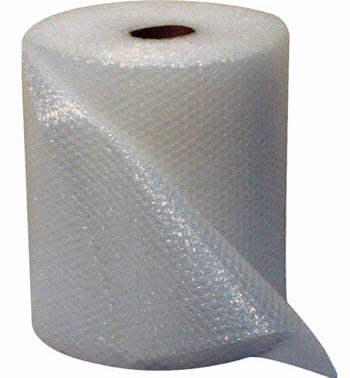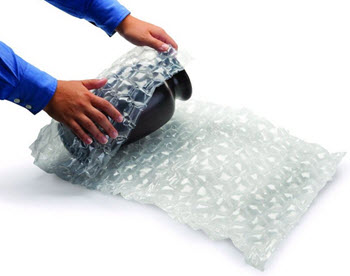Bubble pack is a pliable plastic material where protruding air-filled hemispheres (bubbles) provide cushioning. Bubble pack is commonly used to wrap fragile products, especially during transport from one location to another.
What’s in a name?
 In colloquial speech, bubble pack is typically referred to as bubble wrap. However, since the names Bubble Wrap and BubbleWrap are Sealed Air Corporation registered trademarks, many companies use other terms when marketing their products, such as:
In colloquial speech, bubble pack is typically referred to as bubble wrap. However, since the names Bubble Wrap and BubbleWrap are Sealed Air Corporation registered trademarks, many companies use other terms when marketing their products, such as:
- Bubble Pack
- Air Bubble Packing
- Aeroplast
- Bubble Paper
Material
Most bubble pack products are made from polyethylene (LDPE) film, where a shaped side is bonded to a flat side to form the air bubbles.
Bubble size
Bubble pack is available with bubbles of varying sizes to accommodate for the needs of various fragile objects. The ideal size of the bubbles will depend both on the size of the object and on the level of cushioning required.
The most commonly utilised bubble pack have bubbles that are approximately 1 cm in diameter, but anything from 6 mm to 2.6 mm in diameter is considered within the normal range.
Bubble pack resistance in vacuum
To reduce the loss of air when the bubble pack is kept in a vacuum, bubble pack with a specially adjusted permeation barrier to film is recommended.
Envelopes
Envelopes with integrated bubble pack are available for shipping delicate products.
Anti-static bubble pack
Anti-static bubble pack is made from anti-static plastic and will dissipate static charge. This is useful when shipping or storing electronic items that are sensitive to static electricity.
History
The bubble wrap was invented by Alfred Fielding and Marc Chavannes in 1957. They were not trying to make a cushioning packaging material; what they wanted to create was a three-dimensional plastic wallpaper. Their product was considered a failure as a wall paper, but the inventors realised it could be used as packing material instead and as such it became a huge success.
In 1960, the Sealed Air Corporation was co-founded by Fielding. That same year, IBM used bubble pack to protect the new IBM 1401 computer when shipping it. This was one of the very first commercial uses of bubble pack, and many of the computer buyers were quite mesmerised by the novel packaging material.
The Sealed Air Corp. still exists today, but statistics from 2012 show that the sales of Bubble Wrap made up less than 4% of their total sales. That same year, the new chief executive Jerome Peribere ordered the closing of Bubble Wrap factories in Mexico and South Africa.
Legal
 While the term bubble wrap started out as a trademark belonging to the Sealed Air Corporation, it is today considered a rather degenerated trademark since it is so widely used to describe all products of this type – not just the ones produced by the trademark holder. Still, it is a trademark registered by the Sealed Air Corporation so many producers use other names when marketing their bubble packaging, such as bubble paper, bubble pack, air bubble pack or aeroplast.
While the term bubble wrap started out as a trademark belonging to the Sealed Air Corporation, it is today considered a rather degenerated trademark since it is so widely used to describe all products of this type – not just the ones produced by the trademark holder. Still, it is a trademark registered by the Sealed Air Corporation so many producers use other names when marketing their bubble packaging, such as bubble paper, bubble pack, air bubble pack or aeroplast.
Sealed Air Corporation’s patent for Bubble Wrap expired in 1981, but Sealed Air Corp. still consider its manufacturing process a trade secret. The process involves melting resin pellets and stretching them over rollers.
It’s fun to pop
If you press one of the bubbles in the bubble pack using your fingers, you don’t have apply much pressure before the bubble bursts – producing a popping sound that many people find oddly satisfying. The bubbles can also be popped using other techniques, including methods that make it possible to pop multiple bubbles at a time.
Virtual popping
Several web sites provide virtual bubble popping. A sheet of bubble pack is displayed on your computer screen and you can pop individual bubbles by clicking on them.
Mugen Puchipuchi
Mugen Puchipuchi is a Japanese keychain toy designed to mimic the sensation of popping bubble pack – including the distinctive sound. It is produced by Bandai (Asovision). Puchipuchi is the onomatopoetic Japanese name for bubble pack, and mugen means infinite.
In 2008, Bandai released a video game version for Nintendo Wii titled Ouchi de Mugen Puchi Puchi Wii. This roughly translates into “In your home infinite bubble pack Wii”.
iBubble Wrap – not for popping
In 2015, Sealed Air Corp. announced its controversial decision to start producing iBubble Wrap – a bubble wrap that is difficult to pop. The packaging is sold in flat plastic sheets and the shipper will be responsible for filling them with air using a special pump. One roll of non-inflated iBubble Wrap only takes up 1/50 as much space as the inflated product.
The iBubble Wrap consists of columns of connected air pockets. This means that when you squeeze one of the pockets, air gets pushed into neighboring bubbles.
Bubble Wrap Appreciation Day
Bubble Wrap Appreciation Day is celebrated on the last Monday of January. It has its origins in Bloomington, Indiana where a local radio station received a shipment of microphones wrapped in bubble wrap. After having unwrapped and installed their new microphones, the radio station inadvertently broadcast the sound of the bubble wrap being popped.
